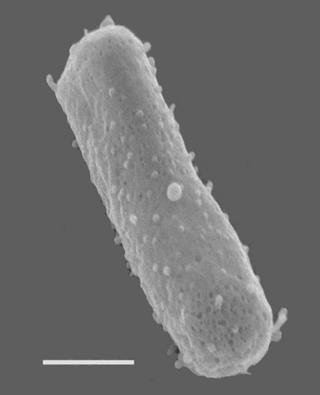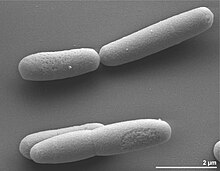A halophile is an extremophile that thrives in high salt concentrations. In chemical terms, halophile refers to a Lewis acidic species that has some ability to extract halides from other chemical species.

Halobacterium is a genus in the family Halobacteriaceae.
Sulfur-reducing bacteria are microorganisms able to reduce elemental sulfur (S0) to hydrogen sulfide (H2S). These microbes use inorganic sulfur compounds as electron acceptors to sustain several activities such as respiration, conserving energy and growth, in absence of oxygen. The final product of these processes, sulfide, has a considerable influence on the chemistry of the environment and, in addition, is used as electron donor for a large variety of microbial metabolisms. Several types of bacteria and many non-methanogenic archaea can reduce sulfur. Microbial sulfur reduction was already shown in early studies, which highlighted the first proof of S0 reduction in a vibrioid bacterium from mud, with sulfur as electron acceptor and H
2 as electron donor. The first pure cultured species of sulfur-reducing bacteria, Desulfuromonas acetoxidans, was discovered in 1976 and described by Pfennig Norbert and Biebel Hanno as an anaerobic sulfur-reducing and acetate-oxidizing bacterium, not able to reduce sulfate. Only few taxa are true sulfur-reducing bacteria, using sulfur reduction as the only or main catabolic reaction. Normally, they couple this reaction with the oxidation of acetate, succinate or other organic compounds. In general, sulfate-reducing bacteria are able to use both sulfate and elemental sulfur as electron acceptors. Thanks to its abundancy and thermodynamic stability, sulfate is the most studied electron acceptor for anaerobic respiration that involves sulfur compounds. Elemental sulfur, however, is very abundant and important, especially in deep-sea hydrothermal vents, hot springs and other extreme environments, making its isolation more difficult. Some bacteria – such as Proteus, Campylobacter, Pseudomonas and Salmonella – have the ability to reduce sulfur, but can also use oxygen and other terminal electron acceptors.

Halobacterium salinarum, formerly known as Halobacterium cutirubrum or Halobacterium halobium, is an extremely halophilic marine obligate aerobic archaeon. Despite its name, this is not a bacterium, but a member of the domain Archaea. It is found in salted fish, hides, hypersaline lakes, and salterns. As these salterns reach the minimum salinity limits for extreme halophiles, their waters become purple or reddish color due to the high densities of halophilic Archaea. H. salinarum has also been found in high-salt food such as salt pork, marine fish, and sausages. The ability of H. salinarum to survive at such high salt concentrations has led to its classification as an extremophile.
Chromohalobacter beijerinckii is a motile, rod-like, salt-loving, Gram-negative soil bacterium, 0.4–0.6 μm by 1.8–2.5 μm.
Chthonomonas calidirosea is a Gram-negative bacterium and also the first representative of the new class Chthonomonadetes within the phylum Armatimonadota. The Armatimonadota were previously known as candidate phylum OP10. OP10 was composed solely of environmental 16S rRNA gene clone sequences prior to C. calidirosea's relative, Armatimonas rosea's discovery. It is now known that bacterial communities from geothermal environments, are generally constituted by, at least 5–10% of bacteria belonging to Armatimonadota.
Acidobacterium capsulatum is a bacterium. It is an acidophilic chemoorganotrophic bacterium containing menaquinone. It is gram-negative, facultative anaerobic, mesophilic, non-spore-forming, capsulated, saccharolytic and rod-shaped. It is also motile by peritrichous flagella. Its type strain is JCM 7670.
Rhodoferax is a genus of Betaproteobacteria belonging to the purple nonsulfur bacteria. Originally, Rhodoferax species were included in the genus Rhodocyclus as the Rhodocyclus gelatinous-like group. The genus Rhodoferax was first proposed in 1991 to accommodate the taxonomic and phylogenetic discrepancies arising from its inclusion in the genus Rhodocyclus. Rhodoferax currently comprises four described species: R. fermentans, R. antarcticus, R. ferrireducens, and R. saidenbachensis. R. ferrireducens, lacks the typical phototrophic character common to two other Rhodoferax species. This difference has led researchers to propose the creation of a new genus, Albidoferax, to accommodate this divergent species. The genus name was later corrected to Albidiferax. Based on geno- and phenotypical characteristics, A. ferrireducens was reclassified in the genus Rhodoferax in 2014. R. saidenbachensis, a second non-phototrophic species of the genus Rhodoferax was described by Kaden et al. in 2014.

Methanohalophilus mahii is an obligately anaerobic, methylotrophic, methanogenic cocci-shaped archaeon of the genus Methanohalophilus that can be found in high salinity aquatic environments. The name Methanohalophilus is said to be derived from methanum meaning "methane" in Latin; halo meaning "salt" in Greek; and mahii meaning "of Mah" in Latin, after R.A. Mah, who did substantial amounts of research on aerobic and methanogenic microbes. The proper word in ancient Greek for "salt" is however hals (ἅλς). The specific strain type was designated SLP and is currently the only identified strain of this species.
Halorhodospira halophila is a species of Halorhodospira distinguished by its ability to grow optimally in an environment of 15–20% salinity. It was formerly called Ectothiorhodospira halophila. It is an anaerobic, rod-shaped Gram-negative bacterium. H. halophila has a flagellum.
Halanaerobium hydrogeniformans is an alkaliphilic bacterium that is capable of biohydrogen production at and 33 °C (91 °F); it is commonly found in haloalkaline lakes.
Halostagnicola larsenii is a non-motile, aerobic, gram-negative, rod shaped archaeon. It is a halophilic, neutrophilic, chemo-organotroph and was isolated from samples taken from a saline lake in China. The etymology of the name comes from hals, halos Greek for salt, stagnum Latin for a piece of standing water, -cola Latin for inhabitant or dweller, and Larsenii named after the Norwegian microbiologist, Helge Larsen, who was a pioneer in research regarding halophiles.
Acidilobus saccharovorans is a thermoacidophilic species of anaerobic archaea. The species was originally described in 2009 after being isolated from hot springs in Kamchatka.
Psychroflexus sediminis is a Gram-negative, mesophilic, slightly halophilic and non-motile bacteria from the genus of Psychroflexus which has been isolated from a salt lake in Qaidam Basin in China.
Dokdonia is a genus of bacteria in the family Flavobacteriaceae and phylum Bacteroidota.
Salisediminibacterium is a genus of Gram-positive bacteria from the family of Bacillaceae. The type species is Salisediminibacterium halotolerans.
Vibrio aerogenes is a gram-negative organism that is rod-shaped and has a two-sheathed flagella that is found on one side of the cell that makes it motile. When it is grown on polypeptone-yeast (PY) plate medium, the colonies are usually round and flat. It is an organism that is mesophilic which means it likes temperatures that are between 20-45°C. In addition, it is facultatively anaerobic, which means it can survive with or without oxygen. This is a marine bacteria that is most commonly found in temperatures between 30°C and 35°C and pH 6-7. It requires Na+ to grow and this is what makes the marine environment a necessity for this organism. V. aerogenes can ferment glucose and a few other carbohydrates to yield organic acids.
Halomonas elongata is considered the type species of the genus Halomonas. It is a chemoorganotrophic, halophilic bacterium first isolated from a solar salt facility located in Bonaire, Netherlands Antilles.
Halanaerobium sehlinense is a Gram-negative, strictly anaerobic, extremely halophilic, rod-shaped, non-spore-forming and non-motile bacterium from the genus of Halanaerobium which has been isolated from sediments from the Sahline Sebkha in Tunisia.
Halanaerobium fermentans is a Gram-negative and strictly anaerobic bacterium from the genus of Halanaerobium which has been isolated from puffer fish ovaries.



